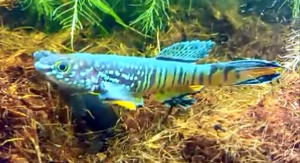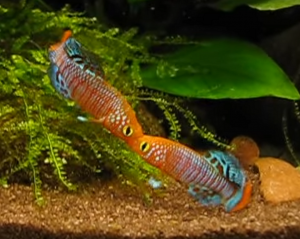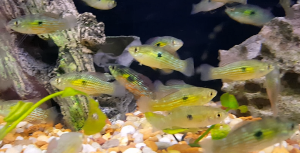Acquiring Killifish for the home aquarium can be a challenging proposition. With only a few exceptions, most pet shops do not normally have a supply of killifish, and those that do usually bring in Fundulopanchax gardneri, Aphyosemion australe, or Fundulopanchax sjoestedti.
The more unusual and rarer species are seldom, if ever, found in tropical fish shops.
Fortunately, we now have access to the internet which allows killifish enthusiasts the ability to purchase the eggs or adults from specialty breeders, importers, and members of various killifish organizations throughout the world.
Although having the means to acquire killifish for the home aquarium makes the job of finding them easier, it can be a challenge (especially for beginners) to know which species to purchase.
Unlike most tropical fish species that have common names, killifish are generally referred to by their scientific names.
This requires some education which can only be provided by joining a killiefish association, a killie group, a club, or learning about them from books, journals, or other publications on or off line.
Although some pet store proprietors are familiar with killifish, many owners sell fish that are incorrectly identified by their suppliers.
Many killifish species and local strains look very similar to each other and can easily be misidentified. In addition, many unnamed or unidentified species that are collected in the wild are often combined with shipments of identifiable fish and shipped to importers as a by catch.
Nothobranchius rachovii Beira ’91, is a beautiful killifish strain that is identified by the year it was originally collected (1991), and the locality where it was found. It has no common name.
Tropical fish keeping enthusiasts who are interested in keeping killifish would do well to concentrate on acquiring the following before moving on to some of the rarer and more difficult to keep species.
- Aphyosemion
Aphyosemion is a genus of African rivulines that as the name indicates, is endemic to Africa. The killifish species in this genus are some of most popular with tropical fish keeping enthusiasts and are also the most commonly available.
Almost all of the species in this genus come from West Africa, and are relatively easy to acquire, keep, and breed.
The Lyretail killifish (Aphyosemion australe) comes in three color forms; Chocolate Brown, Orange, and Gold, and is one of the more common killies found in tropical fish shops.
Aphyosemion ahli, Aphyosemion bivittatum, and Aphyosemion calliurum are also relatively common and make good “starter fish” for beginning killifish enthusiasts.
All are beautiful, easy to keep, and most can be easily bred using spawning mops, Java Moss, or floating plants like Water Hyacinth (Eichhornia crassipes).
- Fundulopanchax
Several colorful species of the Fundulopanchax genus of killifish that are found in the near coastal fresh water streams and lakes of Western Africa, are also suitable for beginning killifish enthusiasts.
Among these are Fundulopanchax gardneri, Fundulopanchax sjoestedti, and Fundulopanchax filamentosus.
All of the species in this genus can be found in several color strains, and although some species like Fundulopanchax sjoestedti are more challenging to keep, most of the other species are easy to breed and care for and are suitable for beginning enthusiasts.
Fundulopanchax sjoestedti and Fundulopanchax filamentosus are bottom spawners.
Some species of Fundulopanchax gardneri are topwater spawners, while other species like Fundulopanchax gardneri nigerianus and Fundulopanchax gardneri garderni are both top and bottom spawners.
- Epiplatys
All species in the Epiplatys genus are surface feeding killifish that prey on insects and other organisms that inadvertently fall into the water.
Many species in the Epiplatys genus are larger than the average sized killiefish. All of them are extremely hardy, easy to breed in an aquarium environment, and will lay their eggs on spawning mops or floating plants.
Both Epiplatys sexfasciatus and Epiplatys fasciolatus are good choices for beginner killiefish enthusiasts however, Epiplatys annulatus should be avoided.
- Nothobranchius
Nothobranchius is a genus of small, freshwater, annual killifish that are found mainly in East Africa, from the Sudan to northern South Africa.
Several species occur in the upper regions of the Congo River Basin and two species are found in West Central Africa. The largest number of over 70 species comes from Tanzania.
Without exception, these small East African annuals are prized for their beauty.
Nothobranchius rachovii is considered by many to be the most beautiful fresh water species in the world. Unfortunately, all the species in this genus are short lived.
In their natural habitat, killifish in the Nothobranchius genus inhabit ephemeral pools that fill up during the monsoon season and dry up during the hot months.
Over the years, they have adapted to these harsh conditions and learned to lay their eggs in the substrate. When the pools dry up and the parents die, the embryos survive in the hard clay by entering diapause, and when the pools fill up again during the wet season, the eggs hatch out and the life cycle repeats itself.
Nothobranchius furzeri reach adulthood in only 17 days and live for only 3 to 6 months
Breeding killies in this genus requires the patience of Job. Their eggs need to be dried out of water for prolonged periods of as long as one year before they can hatch.
If you decide to try keeping any of these species, Nothobranchius guentheri or Nothobranchius korthausae would be an excellent choice for a beginner.
Although they are extremely hardy and can be kept in a variety of water conditions, most are susceptible to velvet disease. In their natural habitats, they are often found in hard, alkaline pools of water but they do well in a variety of water conditions.
Adding 1/2 to 1 teaspoonful of salt per gallon of their aquarium water will minimizes any outbreaks.
- Nematolebias
The Nematolebias genus of killifish is native to South America and includes many popular aquarium specimens.
Nematolebias whitei is an elegant, easy to breed killifish suitable for beginning enthusiasts that is also easy to care for, however, like all species in the Nothobranchius genus, patience is needed to breed them. Several months must elapse after spawning before the eggs will hatch out successfully.
- American killiefishes
Several species of killies in the genus Autrofundulus, Cyprinodon, Fundulus, Rachovia, and Rivulus among others, are good candidates for the home aquarium.
Jordenella floridae (the Florida Flagfish) is found throughout the state, and is frequently found in tropical fish shops.
They are interesting, colorful, inexpensive, easy to keep breed, and make an excellent choice for beginner killifish enthusiasts.
Fundulus auroguttatus, Fundulus cingulatus, and the Golden Topminnow (Fundulus chrysotus) are also some of the more colorful North American species that are easily kept in an aquarium environment.
The Desert Pupfish (Cyprinodon macularius) on the other hand, can survive extreme salinities, pH, temperature, and low oxygen content environments, but because it is on the endangered species list would not be an easily acquired species to keep.
Regardless of which genus you acquire your species of killie from, some research is recommended before purchasing your specimen or their eggs.





I would like buy some blue gularis killifish eggs.
Please quoted price.
We do not sell Killifish eggs. Try this link https://tinyurl.com/ydfkq4wl